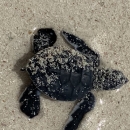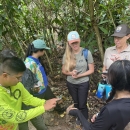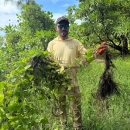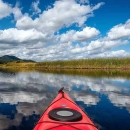States
GuamEcosystem
ForestThe Guam National Wildlife Refuge (Refuge) is undertaking a major project to restore and enhance the native limestone forest on the Refuge with the goal of being able to bring back Guam’s forest birds. In coordination with species experts and other partners, this project will ensure there is enough native plants throughout the Refuge that meets the needs of all forest animals and that the forest is able to regrow with minimal human intervention.
The Refuge contains a couple hundred acres of limestone forest. The quality of the forest has been decreasing over time and was severely decreased as a result of Typhoon Mawar. Refuge Staff hope to restore and enhance the native limestone forest and create a strategy to maintain the newly restored forest. In 2009, the Refuge finalized its Comprehensive Conservation Plan1, which specifies the management direction for the Refuge and identifies several goals, objectives, and strategies for the Refuge. This Project is being designed to meet Goal 1 in the Comprehensive Conservation Plan, which is the restoration of the native limestone forest. This project will implement several strategies and objectives described under Goal 1. The Refuge has partnered with USDA Wildlife Services to determine how best to control feral ungulates and to start the control effort. This project is funded in part by the U.S. Fish and Wildlife Service's Region 1's Invasive Species Small Grant Program.
Project Need:
Several threats currently exist that impedes natural regrowth of a healthy mixture of native species, including non-native plant encroachment, feral ungulate tramping and grazing, and the loss of native pollinators and seed dispersers. Without active management, Refuge staff fear the forest will be overtaken by non-native species, which will negatively impact the forest species that currently use the Refuge and increase the difficulty in bringing back the forest birds.
Goals and Objectives:
- Document the current condition of the forest.
- Conduct a baseline vegetation survey documenting percent cover of all species at different intervals, density of all native species, diameter of all native species, and basic health assessment of each native individual. (Done)
- Determine what species are flowering and fruiting at different times of the year and document their distribution across the forest. (In progress)
- Plan where forest enhancement and forest restoration need to take place.
- In conjunction with species experts, determine what species, in what quantity, and in what location each species needs to be outplanted throughout the Refuge. (In progress)
- Develop a Forest Restoration Plan (Plan) using advice from species experts and staff experience and expertise, determining what success looks like, and making sure the Plan includes protocols on how to monitor for success.
- Based on the Plan, determine what permits will be needed for implementation and apply for all permits.
- Determine how to minimize the impacts of feral ungulates on the east side of the Refuge outside of the multi-species barrier.
- Prepare outplanting sites.
- Control invasive ungulates through trapping. (In progress)
- Determine how hunting will impact the listed species that use the Refuge. If possible, control invasive ungulates through hunting.
- Control invasive plants through mechanical and chemical methods. (In progress)
- Restore the multi-species barrier and implement feral ungulate exclusion techniques on the east side of the Refuge.
- Implement a propagation program.
- Based on the Plan, collect seeds, cuttings, and other planting material from donor plants around the Refuge and propagate planting material in the nursery.
- Outplant species as described in the Plan.
- Implement the Plan’s monitoring protocols.
Project Benefits:
This project will provide Refuge staff a solid foundation for reintroducing forest birds back to the island of Guam. As the project nears completion, Refuge staff will work with experts, such as the USGS and other researchers, to start controlling the brown tree snake population within the multi-species barrier. Only after the habitat has been restored and the brown tree snake population has been controlled, can forest birds be reintroduced.
Project Updates:
Update for 6/6/2025
The biology team has been hard at work. The baseline vegetation surveys have been completed. The biology team have also been working to remove invasive vegetation and debris in a different outplanting site; this one is near the common beach parking area. They have been shredding invasive trees to use for mulch.
The biology team visited UOG's Inarajan Research and Education Center to collect cuttings for eventual outplanting on the Refuge.
The Refuge is working with Kupu Hawaii to hire one more Kupu member. We hope to bring the new member on soon.
Update for 3/29/2025
Kupu member Loren has ended her time with us. Thank you, Loren! University of Guam student, Kana, will be working with us this semester. We look forward to working with you this semester!
The biology team has been conducting the baseline vegetation surveys. We hope to finish these surveys within the next month.
The biology team have also been outplanting at one of our outplanting sites. They removed a lot of vegetation last month and have been excited to plant in the newly cleared area.
Update for 3/1/2025
Our biology team has been hard at work. The focus over the past two months have been on our outplanting sites. They have been repairing the fences surrounding the sites that have been damaged by Typhoon Mawar and have been removing the invasive plants from inside the fences.
Our biology team have also started implementing baseline vegetation surveys. These surveys will take place at 10 locations spread across the Refuge and will be repeated every few years. They will document vegetation growth over time.
The start of the spring semester at the University of Guam signaled the end of Sol and Jeaul's internship. THANK YOU for everything! Another University of Guam student, Angela, will be working with us this semester. She will be taking over the Sol and Jeul's project. We look forward to working with you this semester! So far, Angela and our Kupu members have revisited four of our fanihi transects.
We had two groups assist with vine removal in January. Together they removed 37 contractor bags worth of vines. Thank you everyone who helped!
Update for 1/8/2025
December was also a busy month at the Refuge. James Campbell National Wildlife Refuge's Invasive Species Strike Team member Ty Spangler assisted our Biologist and Kupu members for two weeks with plant removal. Together, everyone removed 0.43 acre of triphasia and about 1,500 square feet of invasive vines from the Refuge. Fantastic work everyone!
In addition, the University of Guam COMPASS students have been hard at work mapping transects, completing all 10 of their fruit bat transects! Now they will transition to collecting fruit bat droppings, which will be analyzed to determine what they are eating. We hope to outplant more of their food across the refuge (particularly where the Biologist and Kupu members are removing invasive plants).
USDA Wildlife Services have been busy trying to control feral pigs on the Refuge. While only being able to operate for the last two months, they have removed 48 pigs from the Refuge. They have been using two corral traps (you can see one outside of the visitor center) and have been baiting the traps with corn.
Update for 11/30/2024
November has been a busy month at the Refuge. The Kupu members have been hard at work at removing invasive plants across the Refuge. Vines have been removed from more than 13,100 square feet of forest in November! University of Guam COMPASS students have been hard at work mapping transects, completing 6 of 10 transects!
The U.S. Fish and Wildlife Service's Pacific Region's Inventory and Monitoring Program visited the Refuge to help staff develop vegetation baseline surveys and identify where they should take place. We'll continue to work with our Inventory and Monitoring Program as we finalize the survey protocols. We hope to start conducting the surveys at the beginning of next year. We have combined Goal 1 Objectives a and b which were:
a. Determine what species comprise different locations of the limestone forest and in what density.
b. Conduct a rough forest inventory analysis at different locations.
And replaced it with:
a. Conduct a baseline vegetation survey documenting percent cover of all species at different intervals; the number of all species; and the diameter, the height, and basic health assessment of all native individuals.
From this information, we can determine the density of native and non-native vegetation in our plots. This survey will also help us document the current condition of our forest and can help us determine what we want success to look like.
Update for 11/15/2024
The Kupu members have been hard at work at removing invasive plants across the Refuge. Vines have been removed from more than 12,500 square feet of forest in October!
Refuge staff has been working with Kupu AmeriCorps to bring one more member onboard. Loren Villanueva joined the teamed on November 4. Welcome aboard Loren!
Our nursery got a makeover thanks to our maintenance staff and biologist. Thank you everyone! It looks great! Shay has been hard at work growing plants from seeds. We can't wait to put them out into the forest.
We are hosting two more University of Guam COMPASS students: Sol and Jeaul. They will be mapping transect lines through our forest to see if they can find Mariana fruit bat droppings and signs of use. Thank you to Dr. Tammy Middlestein for helping us set up these surveys! Welcome Sol and Jeaul!
Update for 10/5/2024
The Kupu members have been hard at work at removing invasive plants across the Refuge. Vines have been removed from more than 18,000 square feet of forest in September! The fence around Outplanting Site 1 along Route 3A Spur Raod is being repaired. Refuge staff hope to target the area within the fence for invasive species invasive species
An invasive species is any plant or animal that has spread or been introduced into a new area where they are, or could, cause harm to the environment, economy, or human, animal, or plant health. Their unwelcome presence can destroy ecosystems and cost millions of dollars.
Learn more about invasive species removal as a volunteer activity.
The Refuge is hosting a University of Guam COMPASS student: Shay. Their project is looking at the phenology of Mariana fruit bat foraging species throughout the Refuge. This data will be invaluable for the Refuge to understand not only the distribution of fruiting species across the Refuge, but also when those species are in bloom and fruiting. The Refuge hopes to outplant specific species from this project with the hope of providing a year-round source of food for the Mariana fruit bat. In addition, they will be helping us grow native plants in our nursery. Welcome Shay!
Update for 8/25/2024
The Refuge is hosting three Kupu members, two of which will be focusing on invasive species removal: Matt and Tatiana. The Refuge has partnered with USDA Wildlife Services to determine the best method for controlling feral ungulates based on the environmental conditions on the Refuge. Refuge staff have also been meeting with species experts and restoration experts to develop a plan on what successful restoration may look like for the Refuge and how to measure and maintain success.
Dångkulu na si Yu’us ma’åse’ to the following people:
Matthew (Matt) Reardon - Kupu AmeriCorps
Tatiana Ananich - Kupu AmeriCorps
Joshua (Josh) Artuz - Kupu AmeriCorps
Loren Villanueva - Kupu AmeriCorps
Chae (Shay) Ragadio - University of Guam COMPASS
Maria (Sol) Marques - University of Guam COMPASS
Jeaulean (Jeaul) Perez - University of Guam COMPASS
Ty Spangler - U.S. Fish and Wildlife Service
Angela Arcega - University of Guam
References:
- U.S. Fish and Wildlife Service. 2009. Guam National Wildlife Refuge Comprehensive Conservation Plan. 357 pages.









